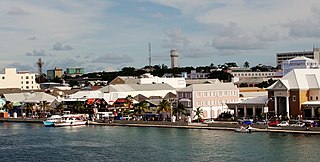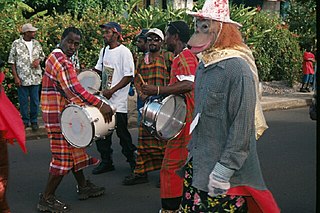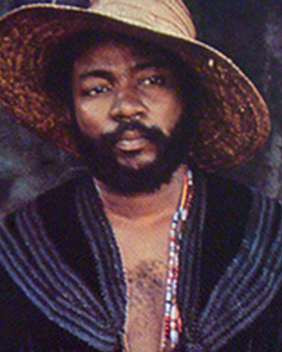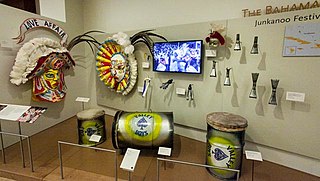
The Bahamas, officially the Commonwealth of The Bahamas, is a country in North America. It is an island country within the Lucayan Archipelago of the West Indies in the Atlantic Ocean. It contains 97% of the Lucayan Archipelago's land area and 88% of its population. The archipelagic state consists of more than 3,000 islands, cays, and islets in the Atlantic Ocean, and is located north of Cuba and northwest of the island of Hispaniola and the Turks and Caicos Islands, southeast of the U.S. state of Florida, and east of the Florida Keys. The capital is Nassau on the island of New Providence. The Royal Bahamas Defence Force describes The Bahamas' territory as encompassing 470,000 km2 (180,000 sq mi) of ocean space.

Nassau is the capital and largest city of The Bahamas. It is located on the island of New Providence, which had a population of 246,329 in 2010, or just over 70% of the entire population of The Bahamas. As of April 2023, the preliminary results of the 2022 census of the Bahamas reported a population of 296,522 for New Providence, 74.26% of the country's population. Nassau is commonly defined as a primate city, dwarfing all other towns in the country. It is the centre of commerce, education, law, administration, and media of the country.
The music of the Bahamas is associated primarily with Junkanoo, a celebration which occurs on Boxing Day and again on New Year's Day. Parades and other celebrations mark the ceremony. Groups like The Baha Men, Ronnie Butler,Kirkland Bodie and Twindem have gained massive popularity in Japan, the United States and other places. Other popular Bahamian artists include Stileet and Stevie S.

The music of Dominica includes a variety of genres including all the popular genres of the world. Popular music is widespread, with a number of native Dominican performers gaining national fame in imported genres such as calypso, reggae, soca, kompa, zouk and rock and roll. Dominica's own popular music industry has created a form called bouyon, which combines elements from several styles and has achieved a wide fanbase in Dominica. Groups include WCK, Native musicians in various forms, such as reggae, kadans (Ophelia Marie, and calypso, have also become stars at home and abroad.
The music of the Lesser Antilles encompasses the music of this chain of small islands making up the eastern and southern portion of the West Indies. Lesser Antillean music is part of the broader category of Caribbean music; much of the folk and popular music is also a part of the Afro-American musical complex, being a mixture of African, European and indigenous American elements. The Lesser Antilles' musical cultures are largely based on the music of African slaves brought by European traders and colonizers. The African musical elements are a hybrid of instruments and styles from numerous West African tribes, while the European slaveholders added their own musics into the mix, as did immigrants from India. In many ways, the Lesser Antilles can be musically divided based on which nation colonized them.

Junkanoo is a festival that was originated during the period of African chattel slavery in British American colonies. It is practiced most notably in Jamaica, The Bahamas and Belize, and historically in North Carolina and Miami, where there are significant settlements of West Indian people during the post-emancipation era. In the present day, there are considerable variations in performance and spelling, but there are the shared elements of masquerade, drumming, dance, and parading.
The music of Grenada has included the work of several major musicians, including Eddie Bullen, David Emmanuel, one of the best-selling reggae performers ever, and Mighty Sparrow, a calypsonian. The island is also known for jazz, most notably including Eddie Bullen, a pianist, songwriter and record producer currently residing in Canada. Kingsley Etienne, a keyboardist, while the Grenadan-American Joe Country & the Islanders have made a name in country music.
The music of Turks and Caicos Islands is best known for its ripsaw music. It is accompanied by an array of instruments, including maracas, triangles, box guitar, conga drums, goat and cowskin drums, accordion, concertina and, most prominently and uniquely, the carpenter saw.
The music of Montserrat is influenced by Irish traditions, noticeable in the set dance-like Bam-chick-lay, and the presence of fife and drum ensembles similar to the bodhrán. Natives are also witness to the jumbie dance, the style of which is still strongly African. Instruments include the ukulele and shak-shak, an African instrument made from a calabash gourd; both of these are used in traditional string bands. Calypso and spiritual-influenced vocal choirs, like the Emerald Isle Community Singers, are popular.

The culture of Dominica is formed by the inhabitants of the Commonwealth of Dominica. Dominica is home to a wide range of people. Although it was historically occupied by several native tribes, it was the Taíno and Island Caribs (Kalinago) tribes that remained by the time European settlers reached the island. "Massacre" is a name of a river dedicated to the murders of the native villagers by both French and British settlers, because the river "ran red with blood for days." Each claimed the island and imported slaves from Africa. The remaining Caribs now live on a 3,700-acre (15 km2) Carib Territory on the east coast of the island. They elect their own chief.
Kaiso is a type of music popular in Trinidad and Tobago, and other countries, especially of the Caribbean, such as Grenada, Belize, Barbados, St. Lucia and Dominica, which originated in West Africa particularly among the Efik and Ibibio people of Nigeria, and later evolved into calypso music.

As an overseas department of France, Martinique's culture is French and Caribbean. Its former capital, Saint-Pierre, was often referred to as the Paris of the Lesser Antilles. The official language is French, although many Martinicans speak a Creole patois. Based in French, Martinique's Creole also incorporates elements of English, Spanish, Portuguese, and African languages. Originally passed down through oral storytelling traditions, it continues to be used more often in speech than in writing.

Macfarlane Gregory Anthony Mackey, known professionally as Tony McKay and Exuma, was a Bahamian musician, artist, playwright, and author best known for his music that blends folk, rock, carnival, junkanoo, calypso, reggae, and African music stylings.
Bahamian Creole, also described as the Bahamian dialect, is spoken by both white and black Bahamians, although in slightly different forms. Bahamian dialect also tends to be more prevalent in certain areas of the Bahamas. Islands that were settled earlier or that have a historically large Afro-Bahamian population have a greater concentration of individuals exhibiting creolized speech; the dialect is most prevalent in urban areas. Individual speakers have command of lesser and greater dialect forms.
Bahamian English is a group of varieties of English spoken in The Bahamas and by members of the Bahamian diaspora. The standard for official use and education is British-based with regard to spelling, vocabulary, and pronunciation; however, perceptions of the standard are more recently changing towards American norms. In particular, 21st-century news-industry and younger Bahamian speakers are often more influenced in their pronunciations by General American English or sometimes even African-American Vernacular English.

Goombay is a form of Bahamian music and a drum used to create it. The drum is a membranophone made with goat skin and played with the hands. The term Goombay has also symbolized an event in the Bahamas, for a summer festival with short parades known as ‘Junkanoo’.
Afro-Bahamians are an ethnicity originating in The Bahamas of predominantly or partial native African descent. They are descendants of various African ethnic groups, many associated with the Bight of Biafra, kingdoms, the Oyo Empire, and the Kingdom of Kongo. According to the 2010 census, 92.7% of The Bahamas' population identifies as mixed African descent.
André Toussaint was a Haitian singer and guitarist who emigrated to Nassau, Bahamas in 1953 and performed there until his death in 1981. He sang and recorded in several languages and in a variety of styles, most notably calypso.
Staniel Cay is an island located in The Exuma Cays, a district of The Bahamas.








